East Asia's oldest farmland discovered in Korea
이 글자크기로 변경됩니다.
(예시) 가장 빠른 뉴스가 있고 다양한 정보, 쌍방향 소통이 숨쉬는 다음뉴스를 만나보세요. 다음뉴스는 국내외 주요이슈와 실시간 속보, 문화생활 및 다양한 분야의 뉴스를 입체적으로 전달하고 있습니다.

[한겨레] Important announcement of land found to have been cultivated during Neolithic period
By Roh Hyung-suk, culture correspondent
The ruins of East Asia's oldest farmland, where Neolithic farmers planted crops five thousand years ago, have been discovered on the East Sea coast of Gangwon.
The National Research Institute of Cultural Heritage unveiled the recently unearthed remains June 26 in a briefing at a Neolithic site (Historic Site No. 426) in the village of Munam, Goseong County. Estimated to be from the middle Neolithic period some time around 3000 BCE, the ruins are from the first confirmed Neolithic farmland in Korea, China, or Japan.
The discovery is being taken as concrete evidence of farming on the Korean Peninsula during the era. Scholars generally believed farming began in earnest during the Bronze Age (1500 BCE--400 CE), when the earliest previously known farmland ruins in Korea originated.
Found in a sand field near the East Sea coast, the ruins consist of upper and lower strata. The upper level has the typical furrowed structure, although the width of the embankment and furrows is not fixed. The lower stratum is also irregular, with winding and angled furrows. Judging from this, the institute said it is possible to ascertain that the farmland dates to before the Bronze Age, when field shapes were standardized.
The institute added that supporting evidence for this conclusion included Neolithic relics unearthed near the lower stratum, including earthenware fragment with a slash pattern, stone arrowheads, and carbonized millet, as well as house lots from the same era dug into the lower stratum's field layer.
Settled agriculture is believed to have begun in the Neolithic period. Evidence has been found in early Neolithic ruins in the Middle and Near East and Europe, but no direct traces of rice fields have been found in East Asia, leading to an ongoing debate over the period when farming first began there.
Indeed, the oldest known rice fields found in Korea to date are from the Bronze Age, in Ulsan's Mugeo neighborhood and Jinju's Daepyeong village. Carbonized rice grains from the same era were also unearthed in the village of Heunam in Gyeonggi's Yeoju County.
But some scholars have recently come out with evidence suggesting that the timeline should be pushed back to the Neolithic period. Last year, Busan's Bokcheon Museum announced that it had found traces of proso and millet marked onto earthenware excavated from Neolithic shell mounds in the city's Dongsam neighborhood.
Curator and excavator staff member Hong Hyeon-u explained, "The conversation in academia so far was at the stage of conjecturing the possibility of Neolithic farming based on things like traces of grains on earthenware and stoneware that appeared to be for farming."
"With this discovery, we are now able to support the conjecture," he added.
Please direct questions or comments to [english@hani.co.kr]
공식 SNS [통하니][트위터][미투데이]| 구독신청 [한겨레신문][한겨레21]
Copyrights ⓒ 한겨레신문사, 무단전재 및 재배포 금지
<한겨레는 한국온라인신문협회(www.kona.or.kr)의 디지털뉴스이용규칙에 따른 저작권을 행사합니다.>
Copyright © 한겨레. All rights reserved. 무단 전재, 재배포 및 크롤링 금지.